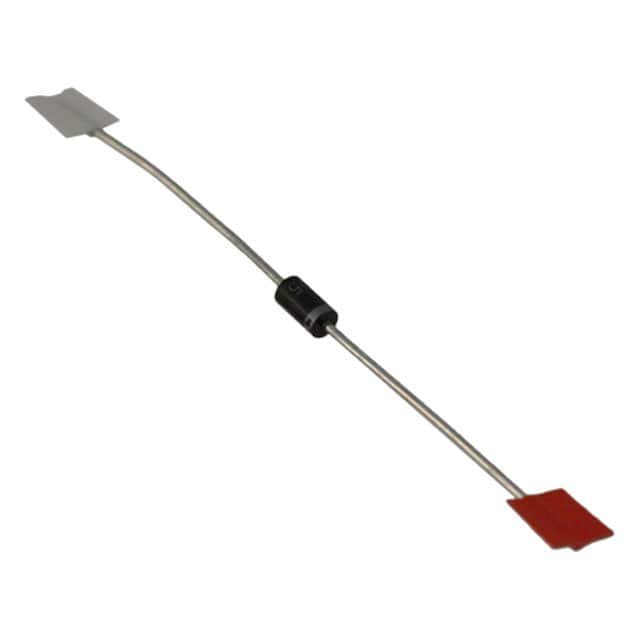1N4002 Diode
Product Overview
The 1N4002 diode is a member of the 1N400x series of rectifier diodes. These diodes are widely used in electronic circuits for their ability to conduct current in only one direction, making them essential components in power supplies and voltage regulation circuits.
Category
The 1N4002 diode falls under the category of rectifier diodes, specifically designed for converting alternating current (AC) to direct current (DC).
Use
It is commonly used in various electronic circuits, including power supplies, battery chargers, and voltage regulators.
Characteristics
- Forward Voltage Drop: 0.93V
- Maximum Reverse Voltage: 100V
- Maximum Average Forward Current: 1A
- Package Type: DO-41
- Packaging/Quantity: Available in bulk packaging with varying quantities
Specifications
- Maximum Repetitive Peak Reverse Voltage: 100V
- Maximum RMS Voltage: 70V
- Maximum DC Blocking Voltage: 100V
- Maximum Average Forward Rectified Current: 1A
- Non-Repetitive Peak Forward Surge Current: 30A
- Operating and Storage Temperature Range: -65°C to +175°C
Detailed Pin Configuration
The 1N4002 diode has two pins, anode, and cathode. The anode is typically marked with a band around the diode body, while the cathode is the other terminal.
Functional Features
The 1N4002 diode allows current to flow in only one direction, from the anode to the cathode, effectively blocking reverse current flow.
Advantages
- Low forward voltage drop
- High surge current capability
- Reliable and cost-effective
Disadvantages
- Relatively slow recovery time compared to fast recovery diodes
- Limited maximum reverse voltage compared to higher voltage diodes
Working Principles
When a positive voltage is applied to the anode with respect to the cathode, the diode conducts and allows current to flow. However, when the voltage is reversed, the diode blocks the current flow.
Detailed Application Field Plans
The 1N4002 diode finds applications in various fields such as: - Power supply circuits - Battery chargers - Voltage regulators - Rectification circuits
Detailed and Complete Alternative Models
Some alternative models to the 1N4002 diode include: - 1N4001: Lower maximum repetitive peak reverse voltage (50V) - 1N4003: Higher maximum repetitive peak reverse voltage (200V) - 1N4004: Higher maximum average forward rectified current (2A)
In conclusion, the 1N4002 diode is a fundamental component in electronic circuits, providing reliable rectification and current control in a wide range of applications.
Word Count: 410
기술 솔루션에 1N4002 적용과 관련된 10가지 일반적인 질문과 답변을 나열하세요.
What is the maximum voltage rating of 1N4002 diode?
- The maximum voltage rating of 1N4002 diode is 100V.
What is the maximum current rating of 1N4002 diode?
- The maximum current rating of 1N4002 diode is 1A.
Can 1N4002 diode be used for rectification in power supplies?
- Yes, 1N4002 diode is commonly used for rectification in low-power applications such as power supplies.
What is the forward voltage drop of 1N4002 diode?
- The forward voltage drop of 1N4002 diode is typically around 0.7V at its rated current.
Is 1N4002 suitable for reverse polarity protection?
- Yes, 1N4002 diode can be used for reverse polarity protection due to its low forward voltage drop and high reverse voltage rating.
Can 1N4002 diode handle surge currents?
- Yes, 1N4002 diode can handle short-duration surge currents, making it suitable for transient suppression applications.
What is the temperature range for 1N4002 diode?
- The operating temperature range for 1N4002 diode is typically -65°C to +175°C.
Is 1N4002 suitable for general purpose rectification?
- Yes, 1N4002 diode is widely used for general purpose rectification in various electronic circuits.
Does 1N4002 have a fast recovery time?
- No, 1N4002 diode has a relatively slow recovery time compared to fast recovery diodes.
Can 1N4002 be used in automotive applications?
- Yes, 1N4002 diode can be used in automotive applications for tasks such as rectification and voltage regulation.


